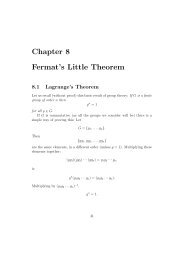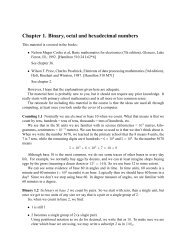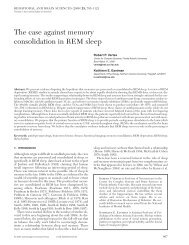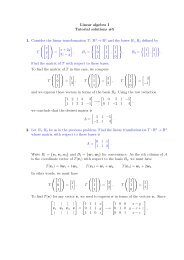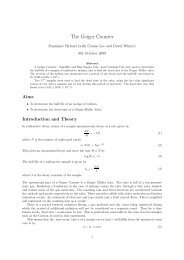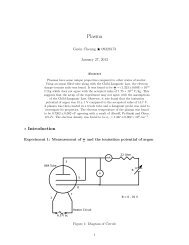Gates and Flip-Flops
Gates and Flip-Flops
Gates and Flip-Flops
Create successful ePaper yourself
Turn your PDF publications into a flip-book with our unique Google optimized e-Paper software.
<strong>Gates</strong> <strong>and</strong> <strong>Flip</strong>-<strong>Flops</strong><br />
Pádraig Ó Conbhuí 08531749 SF WED<br />
Abstract<br />
This experiment was carried out to construct (with the exception of the AND <strong>and</strong> NOT gates) <strong>and</strong><br />
investigate the outputs of AND, NAND, OR, NOR, XOR <strong>and</strong> XNOR gates <strong>and</strong> “J-K master slave flip-flop”<br />
circuits when given different inputs using truth tables, 1 indicating a signal <strong>and</strong> 0 indicating none. Both<br />
asynchronous <strong>and</strong> synchronous counters were then constructed from the J-K master slave flip-flops. The<br />
expected logic tables were constructed <strong>and</strong> the counters worked.<br />
Introduction <strong>and</strong> Theory<br />
In electronics, logical functions are performed based on incoming signals <strong>and</strong> pulses in a circuit. <strong>Gates</strong> <strong>and</strong><br />
flip-flops are used to perform these functions in what is called a logic circuit. In the logic, called transistortransistor<br />
logic (TTL) signals of a st<strong>and</strong>ard size (0V <strong>and</strong> +5V) are used. The presence of a signal is referred to<br />
as a logical 1, or true, while the absence of a signal is referred to as a logical 0, or false. The following gates<br />
perform logical operations, outputting either a logical 1 or 0 based on their inputs.<br />
The NOT Gate<br />
The NOT gate outputs a logical 0 if its input is a logical 1 <strong>and</strong> outputs a 1 if its input is a 0. The<br />
symbol is given.<br />
NOT gate<br />
The AND Gate<br />
The AND gate outputs a logical 1 if <strong>and</strong> only if all inputs are a logical 1 <strong>and</strong> outputs 0 otherwise.<br />
AND gate<br />
The NAND Gate<br />
The NAND gate is an AND gate followed by a NOT gate. Therefore, it outputs a logical 0 if <strong>and</strong> only if<br />
all inputs are a logical 1 <strong>and</strong> outputs 0 otherwise. The symbol is a regular AND gate with a circle at<br />
the output.<br />
NAND gate
The OR <strong>and</strong> NOR Gate<br />
The OR gate outputs a logical 1 if at least one input is a logical 1 <strong>and</strong> a 0 otherwise. The NOR gate<br />
outputs 0 where the OR gate would output 1 <strong>and</strong> 1 where the OR gate would output 0.<br />
OR gate<br />
NOR gate<br />
The XOR <strong>and</strong> XNOR Gate<br />
The XOR gate, or the exclusive OR gate, outputs 1 when one <strong>and</strong> only one of its inputs are a logical<br />
1 <strong>and</strong> 0 otherwise. Similarly, the XNOR gate outputs 1 only when all the inputs are the same, <strong>and</strong> 0<br />
otherwise.<br />
XOR gate<br />
XNOR gate<br />
<strong>Flip</strong>-<strong>Flops</strong><br />
The <strong>Flip</strong>-Flop remains locked on an output of either 0 or 1 until it is given some sequence of inputs,<br />
in which case its output will change. The J-K flip-flop has two outputs, one being the conjugate of<br />
the other. The J-K flip-flop is constructed using NAND <strong>and</strong> NOT gates as shown. The J-K flip-flop<br />
outputs reflect the J <strong>and</strong> K inputs upon the pulse of the clock, but remain locked until then except in<br />
the case where J=K=1 where the outputs simply flip upon a pulse. The “clocked J-K master slave<br />
flip-flop” was used in this experiment. The output of the “clocked J-K master slave flip-flop”<br />
alternates upon a pulse being fed into the clock (a pulse being a sequence of 010 or 101).<br />
J-K flip-flop<br />
Clocked J-K master slave flip-flop
Experimental Method<br />
Care was taken to make sure each gate used was properly connected to the +5V supply <strong>and</strong> properly<br />
grounded in the circuit. The circuits were constructed as instructed <strong>and</strong> outputs were checked using red<br />
LED lights, the light turning on indicating a signal. Inputs came from switches, which could easily be seen to<br />
be on or off, <strong>and</strong> a clock which emitted a pulse on the push of a button or released regular pulses when<br />
set.<br />
Results<br />
A NAND gate with 3 inputs was tested <strong>and</strong> its truth table written out it was found to follow the expected<br />
logic. It was also tested with one input disconnected <strong>and</strong> was found to operate like a 2 input NAND gate.<br />
Input A Input B Input C Output<br />
0 0 0 1<br />
1 0 0 1<br />
0 1 0 1<br />
0 0 1 1<br />
1 1 0 1<br />
1 0 1 1<br />
0 1 1 1<br />
1 1 1 0<br />
- 1 1 0<br />
- 1 0 1<br />
- 0 1 1<br />
- 0 0 1<br />
A NOT gate was put after the NAND gate to create an AND gate <strong>and</strong> the results were tabulated<br />
Input A Input B Input C Output<br />
0 0 0 0<br />
1 0 0 0<br />
0 1 0 0<br />
0 0 1 0<br />
1 1 0 0<br />
1 0 1 0<br />
0 1 1 0<br />
1 1 1 1<br />
A NOT gate was put before one of the inputs of the AND gate <strong>and</strong> the inhibit function of this input on the<br />
other two inputs was tabulated. It was found that a signal is output only if the inhibit is off <strong>and</strong> both inputs<br />
have a signal.<br />
Input A Input B Inhibit Output<br />
0 0 0 0<br />
1 0 0 0<br />
0 1 0 0<br />
1 1 0 1<br />
0 0 1 0<br />
1 0 1 0<br />
Inhibited AND gate<br />
0 1 1 0<br />
1 1 1 0
An OR gate was constructed by placing NOT gates in front of the inputs of a NAND gate. The results were<br />
tabulated.<br />
Input A Input B Output<br />
0 0 0<br />
1 0 1<br />
0 1 1<br />
1 1 1<br />
The NOT gate was constructed similarly, except an AND gate was used, ie a NOT gate was placed in front of<br />
the AND gate.<br />
Input A Input B Output<br />
0 0 0<br />
1 0 1<br />
0 1 1<br />
1 1 1<br />
A XOR gate was constructed from NAND gates <strong>and</strong> its results were tabulated. A XNOR gate was<br />
constructed by placing a NOT gate after it.<br />
XOR gate:<br />
Input A Input B Output<br />
0 0 0<br />
1 0 1<br />
0 1 1<br />
1 1 0<br />
The OR gate<br />
An example OR gate<br />
XNOR gate:<br />
Input A Input B Output<br />
0 0 1<br />
1 0 0<br />
0 1 0<br />
1 1 1<br />
An example XOR gate<br />
The J-K master slave flip-flop was constructed as shown in the introduction <strong>and</strong> the results tabulated.<br />
Input J Input K Clock Q Q<br />
0 1 Pulse 0 1<br />
1 0 Pulse 1 0<br />
1<br />
0<br />
1<br />
0<br />
Pulse<br />
Pulse<br />
Alternates<br />
Stops<br />
Alternates<br />
Stops
Several Counters (Scalers) were constructed using the J-K master slave flip-flop. A counter of scale 16 was<br />
constructed which counted in binary using the LED lights. An asynchronous counter was first constructed. A<br />
scale 10 counter is shown here, but the scale 16 is simply the same without the NAND gate. It was simple<br />
to construct counters of any power of two <strong>and</strong> any other number could be constructed by adding the<br />
equivalent binary outputs for the number to the inputs of the NAND gate. In the diagram shown, the<br />
conjugate of the clear is shown along with an AND gate. A NAND gate without the conjugate is the same<br />
thing.<br />
A synchronous counter was then constructed, which is similar to an asynchronous counter, except that all<br />
of the flip-flips are pulsed simultaneously.<br />
Scale 16 counter:<br />
Pulse 2 0 2 1 2 2 2 3<br />
1 1 0 0 0<br />
2 0 1 0 0<br />
3 1 1 0 0<br />
4 0 0 1 0<br />
5 1 0 1 0<br />
6 0 1 1 0<br />
7 1 1 1 0<br />
8 0 0 0 1<br />
9 1 0 0 1<br />
10 0 1 0 1<br />
11 1 1 0 1<br />
12 0 0 1 1<br />
13 1 0 1 1<br />
14 0 1 1 1<br />
15 1 1 1 1<br />
16 0 0 0 0<br />
Scale 10 counter:<br />
Pulse 2 0 2 1 2 2 2 3<br />
1 1 0 0 0<br />
2 0 1 0 0<br />
3 1 1 0 0<br />
4 0 0 1 0<br />
5 1 0 1 0<br />
6 0 1 1 0<br />
7 1 1 1 0<br />
8 0 0 0 1<br />
9 1 0 0 1<br />
10 0 0 0 0<br />
Scale 10 asynchronous counter<br />
Scale 16 synchronous counter<br />
Discussion <strong>and</strong> Conclusions<br />
The expected truth table for every gate was verified in this experiment. It was shown that there were<br />
several ways to construct each gate from NAND <strong>and</strong> NOT gates, or even purely from NAND gates since a<br />
NOT gate can be constructed from a NAND gate.<br />
The usefulness of J-K master slave flip-flops was shown in the construction of several types of counters.




